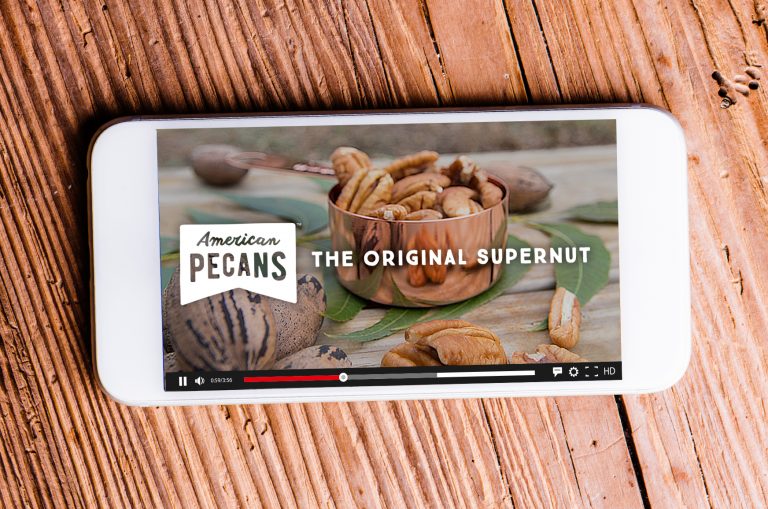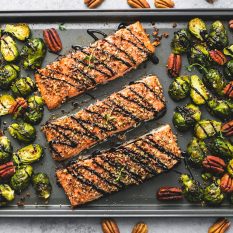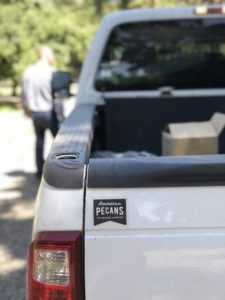
Part 1: Exploring the National Marketing Campaign, Q&A with the APC
Catherine: Molly and Alex, thanks for sitting down with me today. Let’s start by having each of you share a little bit about yourselves and your connection to the American pecan industry.
Molly: My name is Molly Willis, and I live in Albany, Georgia. I serve as the Eastern Small Grower representative on the American Pecan Council. Most of our pecans go to the wholesale trade through both shellers and dealers. Although, we do keep a few hundred pounds each year to share with friends and acquaintances. A bag of fresh pecans is received with about the same enthusiasm as a bag of gold. One reason I’m so excited about the marketing campaign is that so few people have been exposed to a good fresh pecan.
Alex: And I am Alex Ott, Executive Director of the American Pecan Council. I joined the APC in July of this year and work out of the organization’s headquarters in Fort Worth, Texas. I am responsible for overseeing all operations of the American Pecan Council, including USDA relations, research and data collection, and marketing efforts. I have led category organizations for more than a decade; before coming to the APC, I served as Executive Director of the California Apple Commission, California Olive Committee, and the California Blueberry Commission.
Catherine: Thinking about your corresponding positions and experiences, it’s obvious to me that you each can offer a unique insight into the APC’s current marketing efforts. When first thinking of the marketing campaign under the FMO, I know that a lot of people, including myself, expected a campaign similar to “Got Milk?”—with TV commercials and billboards and print ads in magazines and merch. Growing up, I even had “Got Milk?” plates. To put it bluntly, why is the American Pecans campaign so different?
Alex: I have fond memories of Got Milk? too – it’s a great campaign, but it’s important to remember that marketing campaigns are not one-size fits all. There are some key differences between Got Milk? and our program.
First is how much marketing has changed over the years. It’s been almost a quarter of a century since Got Milk? was created as an ad campaign. The way we consume media and what influences our purchase decisions has changed dramatically. For example, today’s consumers spend significant amounts of time on social media and pick up their phones an average of 150 times per day! We’ll have the biggest impact if we can tap into these already established behaviors.
Secondly, while our marketing efforts have the same end goal – to drive consumption – we are starting at different places. We grounded our marketing strategy in consumer research, and that research told us that there was surprisingly low awareness of pecans.
Molly: Yes, familiarity with pecans was lower than almost all other nuts. As someone who works hard to nurture trees and grow pecans, I was shocked that so many thought of pecans as a baking ingredient, rather than a nut. This can be hard to imagine for those of us in the industry, but this is what we heard straight from consumers.
Catherine: So, we’re really having to start from scratch in terms of marketing pecans and consumer awareness.
Alex: Exactly. Most other commodities needed to build product affinity and drive consumption, but they already had a baseline of awareness. Pecans didn’t have that, and awareness is where you have to start. You’ll never increase consumption if people only think of you as a pie ingredient relevant to only a few weeks out of the year. We need people to think about pecans year-round, so much of our work over this first year has been about introducing people to America’s native nut and all the different ways you can use it.
A third difference is budget. It’s not unusual for members of industry to ask why we aren’t doing the same things as other tree nuts with successful marketing orders. We do follow what others are doing with their campaigns and have connected with other boards about best practices; however, we are working with very different budgets than most other groups.
That said, we are using the latest research and proven methods to achieve the biggest impact possible out of every marketing dollar we spend. We work to be good stewards of industry’s funds, and I am pleased to say our marketing spending to date has been very efficient. For every 1,000 people American Pecans marketing has reached, we’ve spent just $7.21, on the low end of the industry average ($7.10-$8.10).
Molly: It’s also worth remembering that many other commodities are decades into their federal marketing campaigns. We’ve only had one full year of marketing pecans. We are very pleased with the progress to date, but we’re cognizant that we are still in the early days. There is much to be done, but initial momentum is encouraging. I know the APC will keep putting in the hard work to get the word out.
Catherine: Once pecans are established and we’ve got a few years under our belts, can we ever expect to see TV commercials or billboards? Why or why not?
Alex: I am not ruling out any method of getting the word out, but in the near-term, TV commercials and billboards are simply not the best use of industry’s marketing budget. A Super Bowl ad easily costs upwards of $5 million. We could spend an entire year’s marketing budget on an impressive ad, but that would be one touch point for an entire year. We have to make industry’s dollars work harder than that.
Molly: I will be the first to admit that it would be amazing to see an ad for American Pecans, The Original Supernut during the Super Bowl – absolutely. But I would much rather the FMO achieve its intended purpose than for me to enjoy that 30 seconds of excitement. The fact is that consumer research shows that a digital approach is much more effective in reaching our audience, both in terms of cost and how to reach people looking for food inspiration.
Alex: Billboards present a different challenge. You get more than 30 seconds, but it would cost a lot of money to reach a meaningful portion of the country.
Catherine: I would assume that gets complicated – determining where to put the billboards.
Alex: Absolutely. We want to get the word out to the entire U.S., and we also want to be equitable within the Pecan Belt. Which state gets the most billboards? And in which part of the state? But the difficult logistics aren’t the determining factor. It comes down to what methods are most likely to drive purchase decisions among our target audience, and billboards don’t rise to the top.
Catherine: Some people would say that it’s important for us to just get our name out there. To have these commercials, billboards or print ads and to know that someone is going to see it and someone is going to remember one fact about pecans. Would you agree with that statement? Why or why not?
Molly: I absolutely agree that we need to raise awareness of pecans. I am not a marketing expert but as a farmer and businesswoman, I know the importance of research and partnering with experts. If research – including third-party research and consumer research conducted on behalf of the APC – tells us that certain methods are more effective in catching consumers’ attention than other methods, it is important to consider and listen to that research.

A family enjoys pecan creations from the menu at The Not Pie Shop. (Diane Bondareff/AP Images for American Pecan Council)
Beyond that, the economics are pretty simple. Some marketing tactics are simply out of our price range. The good news is that we can get great results with other tactics – such as social media – at a much lower price point.
I have been fortunate that as a Council member, I’ve been able to hear firsthand about the research and strategy driving the marketing campaign. Many have not, so I understand why people have questions. This is a well-established industry taking on something very new, and it’s an investment for all of us. It is natural that people would have questions. I’ve asked many questions along the way, and I think it’s important that we continue to do so.
Catherine: Molly, you mentioned that you’ve been really involved since the beginning. You’ve really witnessed the marketing efforts firsthand, and Alex, you are constantly being informed on what’s going on. For those of us outside of the APC, it can be weeks before we see anything. What would you tell a grower that doesn’t follow food bloggers and isn’t on social media? If there are no billboards or TV ads, they likely won’t see much of the American Pecans consumer marketing.
Molly: It’s helpful for me to remember that as a pecan grower, I am not one of the people our marketing efforts are geared toward. Growers and shellers are already convinced about the great taste, versatility and nutrition of pecans.
Yes, I love sharing the wonderful recipes and seeing the beautiful content that is developed for the campaign, but the marketing strategy – both the content and how it is being shared – is not focused on me. In order to sell more pecans, we need people who don’t already love pecans to get to know them. Specifically, we need to reach the moms with kids at home, who are meal planning every week. These consumers are turning to social media and expert bloggers for recipes and advice on how to feed their families, so that’s where we need to reach them.



Alex: We have the best opportunity to encourage pecan consumption if we intersect with consumers where they are already spending time, which also happens to be where they go for food inspiration. 90 percent of foodies turn to websites and social media to get food information.
Molly: And it’s not just foodies. Many moms look to these same sources. I was able to meet some of the food bloggers and recipe developers who are partnering with APC. They are excited to be working with pecans, and we benefit from the fact that they have loyal, established followers. People come to them for meal inspiration, and they are now suggesting meals with pecans. Their endorsement is powerful.
Alex: It’s true. Earlier this year, an interesting report came out about how different generations are most likely to discover a product. Baby boomers are most likely to learn through print magazines, newspapers and TV ads. Millennials, on the other hand, were more likely to discover a brand through endorsements by well-known individuals and posts by expert bloggers. Billboards didn’t even make the list.
In the first full year of marketing efforts, we actually hit all of those elements except for TV ads. We secured features on local and national TV shows, but no commercials. The APC cast a fairly wide net with marketing efforts over the last year, as most Americans are a potential consumer and we needed to raise general awareness. Pecans appeared in thousands of print, online and broadcast news stories – five times more than the prior year. We also partnered with food bloggers, and we got the word out through multiple social media channels.
Catherine: That’s what’s been done so far. What can we expect in the second year of marketing?
Alex: We will continue to use these proven methods, but we plan to lean in even further on social media. Molly mentioned moms, and that is a target we are going to focus on more this year. We looked at which demographic represents our biggest and best opportunity to sell pecans. The answer was Gen X and Gen Y moms (which includes Millennials) who have children still living at home.
We aren’t going to ignore other demographics, but now that we’ve laid the groundwork for broader awareness, much of our year 2 strategy will be geared to this audience. These moms are feeding multiple mouths every day and represent significant purchase power. We also have a lot to offer them – great taste, nutrition and inventive recipes.
Catherine: You’ve given me a big picture understanding of the campaign, but I’m also really interested in hearing about the fine details. Tell me a bit about some of the choices that have been made regarding the marketing campaign and the reasoning behind those decisions. (e.g. why aren’t we comparing pecans to almonds or other tree nuts?)
Alex: What is interesting is that our consumer research showed us that comparing pecans to other nuts was by far the least compelling message for consumers. In fact, many consumers found these types of comparisons off-putting. As our program progresses, we’ll continue to test messages and use consumer research to inform our approach.
Molly: You’ll notice a theme in many of our responses – research. These marketing efforts are very important to those of us who make a living in the pecan industry, and the APC takes that seriously.
Catherine: How so?
Molly: To make sure they got it right, the APC did two very smart things from the beginning. They partnered with a global marketing agency who has successfully done this kind of work for numerous food commodities.
And secondly, they started everything with research. The APC didn’t just want to do what they thought would work. They wanted to partner with the experts and have their strategy rooted in consumer insights. Qualitative and quantitative research was one of the first steps taken by the APC. This gives me confidence that we are on the right path.
Catherine: How do you foresee the marketing efforts affecting growers specifically? For instance, could growers possibly expect a more stable market or higher prices? Please be specific.
Alex: Our job isn’t to set prices. Our mission is to market American Pecans to the benefit of the entire U.S. pecan industry. For generations, the consumption and production of pecans have been relatively flat. Without a united marketing effort, it is very difficult to grow demand.

A grower proudly displays the new American Pecans logo on his pickup truck. (Photo courtesy of American Pecan Council)
There is, however, a track record of many FMOs who were able to greatly increase demand through established marketing programs. I have had the pleasure of leading some of these successful efforts. We are early in the American Pecans marketing program, and our industry is facing some strong headwinds that are out of the industry’s control. But I fully expect that we too will have a positive and lasting impact on the American pecan industry.
Molly: Growing pecans teaches you patience. It takes about a decade for a tree to fully produce, and they require a lot of nurturing in the meantime. It’s really the same here. Our marketing program isn’t going to produce overnight, but I feel confident about the roots that the APC has planted in good soil.
There has been a lot of hard work over the last year and some exciting victories along the way. Seeing pecans featured in USA Today or on Good Morning America; hearing from friends and family that they are seeing amazing pecan recipes from popular bloggers come through their social media feed; witnessing more than a thousand New Yorkers come to the launch event; having the opportunity to meet food editors at Rachel Ray Everyday and Family Circle – the APC is building momentum unlike anything our industry has done before.
There are many reasons to be encouraged, but I also know that this is the beginning and we need to let the program take root. I didn’t expect demand to double in its first year. I too look at the big marketing programs of other nuts or fruits, but I also remind myself that where they are now is not where they started. We are building for the future.
Catherine: We’ve covered a lot in this part of our conversation. And we’re going to cover even more in part 2. As we wrap up, is there anything we didn’t touch on that you’d like to discuss?
Molly: If growers have questions, I’d encourage them to reach out to the APC. Read the newsletters, attend an event where they are speaking, or send an email to Alex and the team at the APC.
Your input is important, and there are also many resources provided by the APC that would likely benefit your business. Be sure to find out what those are. We can promote our own businesses while also raising the overall profile of American Pecans.
Alex: Absolutely. As the new executive director, one of my top priorities is to make sure we are communicating with industry more often, and that includes sharing updates on our marketing efforts and making resources available. We share a monthly newsletter about industry news and a second monthly newsletter about marketing efforts, including results. You can sign up on AmericanPecan.com.
Next month we’ll also share an update that looks at results to date for the marketing campaign. But like Molly said, we also welcome questions. I enjoy connecting with industry and value their feedback. Their questions can also help us identify where we need to do a better job of proactively updating industry. We’re committed to continual improvement.
Read the second part of this Q&A in the November issue of Pecan South.